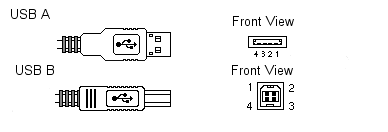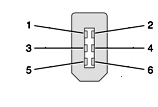1. USB
USB stands for Universal Serial Bus. The most important features of USB bus include the following:
USB connectros can be broadly divided into USB A, and USB B. The difference between the two is in the physical layout of pins in the connector. Both are shown in the figure below.

| Pin # | Function |
| Pin 1 | +5V DC |
| Pin 2 | Data- |
| Pin 3 | Data+ |
| Pin 4 | Ground |
USB"A" plugs are used towards the host system and USB "B" plugs are used towards the USB device.
2. FireWire/IEEE1394
FireWire/IEEE1394 port provides data rates up to 400 Mb/sec. The standard is most suitable for transferring high volumes of information including video, and voice data.
Given below are some of the important features of IEEE 1394 standard:
4 PIN IEEE1394 (without Power)

A IEEE 1394 Connector schematic
| Pin | Function |
| Pin #1 | Twisted-pair B, differential signals, TPB- |
| Pin #2 | Twisted-pair B, differential signals, TPB+ |
| Pin #3 | Twisted-pair A, differential signals, TPA- |
| Pin #4 | Twisted-pair A, differential signals, TPA+ |
6 PIN IEEE1394 (with Power):

IEEE1394 6-pin connector schematic.
| Pin # | Function |
| 1 | Power, 18-28v no load. |
| 2 | Ground |
| 3 | Twisted-pair B, differential signals, TPB- |
| 4 | Twisted-pair B, differential signals, TPB+ |
| 5 | Twisted-pair A, differential signals, TPA- |
| 6 | Twisted-pair A, differential signals, TPA+ |
Download practice tests:
Download Sim-Ex™ Practice Exams for A+ Core 1
Download Sim-Ex™ Practice Exams for A+ Core 2
Related practice tests:
Sim-Ex™ Practice Exams for Network+
Sim-Ex™ Practice Exams for Server+
Sim-Ex™ Practice Exams for Security+
Disclaimer: Simulationexams.com is not affiliated with any certification vendor, and Sim-Ex™ Practice Exams are written independently by SimulationExams.com and not affiliated or authorized by respective certification providers. Sim-Ex™ is a trade mark of SimulationExams.com or entity representing Simulationexams.com.A+™,Network+™,Security+™,Server+™ are trademark of CompTIA® organization.